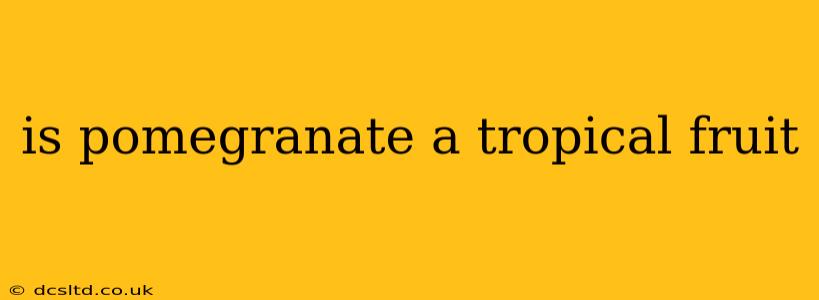The simple answer is no, pomegranate is not a tropical fruit. While it thrives in warm climates and is often associated with tropical regions due to its prevalence in those areas, it's actually a subtropical fruit. This distinction is crucial because it highlights the pomegranate's adaptability and hardiness.
Let's delve deeper into understanding the difference and explore what makes pomegranates unique.
What's the Difference Between Tropical and Subtropical Fruits?
The key difference lies in the temperature requirements for growth. Tropical fruits require consistently warm temperatures throughout the year, ideally without frost. Subtropical fruits, on the other hand, can tolerate some cooler temperatures, even mild frosts, but still prefer warm climates for optimal growth. Pomegranates fall into the latter category. They can withstand some freezing temperatures, albeit briefly, which is why they can be successfully cultivated in regions outside purely tropical zones.
Where Do Pomegranates Grow Best?
Pomegranates thrive in regions with warm, dry summers and mild, not freezing, winters. They prefer full sun and well-drained soil. This explains their prevalence in regions like the Mediterranean, parts of India, and some areas of Central Asia, all of which share a subtropical climate profile.
What are the ideal growing conditions for pomegranates?
Pomegranates require a specific set of conditions to flourish. Here's a breakdown:
- Climate: Warm, dry summers and mild winters are essential. Temperatures consistently below freezing can damage or kill the tree. Ideally, the average temperature should be above 10°C (50°F).
- Sunlight: Pomegranates need plenty of sunlight, ideally at least 6-8 hours per day.
- Soil: Well-drained soil is crucial. Pomegranates are sensitive to waterlogged conditions which can lead to root rot.
- Watering: Regular watering is necessary, especially during dry periods, but avoid overwatering.
Are there any varieties of pomegranate that tolerate colder climates?
While most pomegranate varieties prefer warmer climates, some varieties exhibit slightly better cold hardiness than others. Breeders are constantly working to develop varieties that can tolerate lower temperatures, extending the pomegranate's geographic range. However, even the cold-hardy varieties still need protection from prolonged freezing temperatures.
How cold can a pomegranate tree withstand?
This depends greatly on the specific variety and the tree's age. Generally, mature trees can handle short periods of temperatures down to around -12°C (10°F) without significant damage, although leaf drop and some dieback can occur. Younger trees are more vulnerable to cold damage and require more protection.
Conclusion: Pomegranates – Subtropical Stars
While often found in regions with a tropical feel, pomegranates are definitively subtropical fruits. Their ability to withstand some cooler temperatures differentiates them from their purely tropical counterparts. Understanding their climate requirements helps to appreciate their adaptability and widespread cultivation across various parts of the world.
